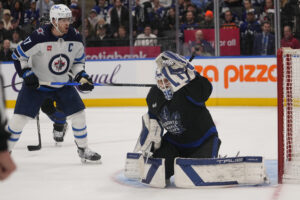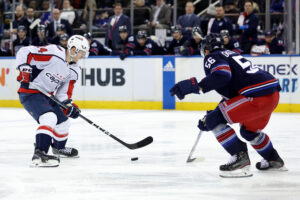Player development seems to always result in more questions than answers. How likely is it for a top pick to pan out? What makes a player a “steal”? Last Word On Hockey will be starting a new series on how to properly develop prospects from all different spots throughout the draft. This week’s piece involves top-10 picks and how they were used early in their careers.
Player Developments of Top 10 Picks
In the span of 2005 through 2015, there were 40 total selections made between fourth overall and tenth overall on forwards playing in North America. Of those 40 selections, two players were given immediate NHL roles, without being deemed NHL ready. For those not sure what those categories entail, check out my previous articles on top three picks. For now, let’s get into those two aforementioned players.
Player Development of Sam Gagner
Sam Gagner was deemed not NHL ready, based on his DY-1 and DY stats. Yet, after being selected sixth overall by the Edmonton Oilers in 2007, he was given an immediate NHL role. Thus, he landed in the “Forwards rushed slightly” category. In his DY-1 season, Gagner played for the Sioux City Musketeers of the USHL. There, he would score 11 goals and 35 assists for 46 points in 56 games, recording a 0.821 points per game pace. That ranked 25th out of those 40 selections mentioned above among DY-1 stats. He ranked in the bottom half despite playing in a relatively weaker league.
However, Gagner would bounce back in a massive way in his draft year. Joining the London Knights of the OHL, Gagner would score 35 goals and 83 assists for 118 points in 53 games. That would rank first among those 40 selections for DY production. However, because of his poor season in the USHL the year prior, he fell into not being NHL ready right away. Regardless, the Oilers gave him an immediate role.
How was Gagner used?
In his first professional season, Gagner slotted into 79 games, scoring 13 goals and 36 assists for 49 points. He did that while averaging 15:41 time on ice per game. He finished seventh in Calder voting for that performance. As for the analytics, Gagner would join just three other North American forwards taken in the top-10 from 2005 to 2015 to post all above replacement-level scores. His EVO score was 3.1 and his EVD score was 0.1. As for his WAR and GAR, he would post 1.4 and 7.5 scores, respectively.
In his second season, Gagner would play 76 games, recording 16 goals and 25 assists for 41 points. The production was a step-down, but his role grew. He would average 16:46 of time on ice per game. For the analytical crowd, Gagner would produce a 4.4 EVO, 0.9 EVD, 1 WAR and 5.8 GAR. His even-strength performance in year two improved slightly from his rookie year, but overall, his analytics also took a slight step back.
A Rough Year Three
In Gagner’s third season, he would slot into 68 NHL games, producing 15 goals and 26 assists for 41 points, matching his year two production in fewer games. He averaged just about the same ice time per game, with an average of 16:17 per night. However, his analytics took a hit. He would drop in every category in year three. His EVO fell to a score of 3, and his EVD dropped slightly to 0.7. His WAR total also fell, recording a 0.7 score, while his GAR dropped to 3.7.
Following those first three years in the league, his next five seasons he would record between 37 and 47 points. His ice time surpassed 19 minutes just once, in the lock-out shortened 2012-13 season. Ultimately, Gagner would remain a solid middle-six forward for most of his career. The team wasn’t wrong with the way they developed him, the player simply never produced well enough within his first three years to earn first-line opportunities. The player development for Gagner was not perfect, but it certainly could have been a bit better.
Player Development of Mikkel Boedker
Mikkel Boedker, who was selected eighth overall by the then-Phoenix Coyotes in 2008, made a tough, but positive decision in his draft year. He moved from Sweden, where he played hockey for several seasons, to Canada, where he played for just one season. In his DY-1 season, Boedker played in the U20 SuperElit league with Frolunda HC. He scored 19 goals and 30 assists for 49 points in 39 games played. That scoring gave him a rate of 1.256 points per game, ranking eighth out of those aforementioned 40 forwards for DY-1 production.
In his DY season, moving to Canada to play for the OHL’s Kitchener Rangers, Boedker produced 29 goals and 44 assists for 73 points in 62 games played. That was a rate of 1.177 points per game in his first taste of OHL action. That production ranked 27th out of those same 40 forwards in DY production. However, his smooth transaction from Sweden to the smaller rinks in Canada was enough for the Coyotes to earn an immediate role in the NHL.
How was Boedker used?
In his first NHL season, Boedker went on to play 78 NHL games, averaging 15:32 ice time per game in the process. He went on to record 11 goals and 17 assists for 28 points. As for analytics, Boedker saw an EVO score of 2.8 and an EVD score of -0.4. Additionally, he saw a 0.3 WAR and 1.4 GAR. Those numbers aren’t great by any stretch, but he was in no way a hindrance on his team.
Despite being reliable at the least as a rookie, he would see a dramatic drop in his role with the team. Playing in just 14 NHL games, along with a 64 game AHL stint, Boedker averaged just 8:43 time on ice per game. He scored just three points at the NHL level, and 11 goals and 27 assists for 38 points in the AHL. His fourth-line NHL deployment held his offence back in a big way, as his EVO score fell to -0.1. Meanwhile, his EVD jumped up to a 1.1 score, showing a tiny bit of promise moving forward. As for his WAR and GAR, he scored a 0.4 and a 2.0, respectively. Simply a disastrous season, which can be blamed on him playing a fourth-line role with a skill-set that does not work in a fourth-line role.
More Struggles In Boedker’s Player Development
As for Boedker’s third season, it would be more of the same. He would split the year between the NHL and AHL almost in half, with 34 NHL games and 36 AHL games. He would average just 10:54 time on ice per game, which is still mostly fourth-line minutes. Boedker scored four goals and 10 assists for 14 points in those 34 NHL games, as well as 12 goals and 22 assists for 34 points in those 36 AHL games. His analytics in the NHL went back up in a big way, despite the small role. His GAR rose to 2.0, his WAR jumped to 0.7, a new best, and his GAR rose to 4.0, another new best. The only thing that dipped was his EVD, which fell down to a -1.4 score.
Following those first three years, Boedker would only play over 18 minutes per game in a season twice in the nine following seasons. His raw stats were very inconsistent as well, with point totals of 24, 26, 51, 28, 51, 26, 37, 35 and four, in order of seasons. In his two 51-point campaigns, he averaged 17:25 and 18:30. Those averages rank fourth and first in his career.
Where Are They Now?
Both Gagner and Boedker have switched teams through their careers. For Gagner, he played with Edmonton for his first seven years, peaking at 47 points (2011-12) and 19:25 average time on ice (2012-13). He then signed with the Coyotes for a year, with 41 points and 17:15 average time on ice. After that season, he would play one season in Philadelphia, then one season in Columbus. With those two teams, he had a high of 50 points and a 13:52 average time on ice. In the last three seasons, Gagner has played for Vancouver, Edmonton and Detroit, with 15 points being his best out-put.
Ultimately, Gagner was the ultimate role player, finding success based on the opportunity he was provided. When Gagner was awarded good minutes, he would produce fairly well. If he was given a small role, his production would fall, but he would play well defensively to make up for it. It’s difficult to say for sure, but with that in mind, there could’ve been a chance for Gagner to grow into a very strong complementary piece if he was handed a larger role earlier on in his career. Chalk that up as a slight mistake in player development, but not a big one.
Boedker’s Strange Development
As for Boedker, his player development is very difficult to follow. His rookie year started the way you want a prospect to start; moderate production, reliable analytics, and a decent role. Yet they followed it up with two separate stints splitting between the AHL and NHL, with a massive drop in ice time at the NHL level, despite still posting moderate analytical numbers. In his fourth year, he would see his first full 82-game season, but he still only averaged 13:38 time on ice per game. It took his fifth season, the lock-out shortened 2012-13 season, to average a strong role of 18:29 time on ice per game. But his production was not the best, and his role fell back down to 17:25 the following year.
Despite the fall in ice time, Boedker would produce his career-best season that year. Yet, that wasn’t enough to earn a raise the following season, and his production would fall right back to his usual production. For Boedker, the skill was very much there. What the Coyotes should have done was let him play one more season in the OHL to further acclimate himself to the smaller North American rinks, and give him a consistent NHL role, rather than the yo-yoing he experienced within his first three pro seasons.
All advanced stats in this piece come from Evolving-Hockey.
Main Photo:






